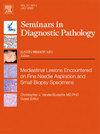Targetoid hemosiderotic hemangioma: A review article
IF 3.5
3区 医学
Q2 MEDICAL LABORATORY TECHNOLOGY
引用次数: 0
Abstract
Background
Targetoid hemosiderotic hemangioma (THH), also known as hobnail lymphatic malformation (HLL) or hobnail hemangioma, is an uncommon, acquired vascular lesion with a dynamic presentation and an unclear etiology. It predominantly affects adults with an age range from 9 to 78 years and has no gender predilection. The lesion is thought to arise from trauma, leading to micro-shunts between small lesional capillaries and adjacent lymphatic vessels.
Methods
This review article examines the clinical, histologic, and immunohistochemical characteristics of THH, and explores its differential diagnoses, including Kaposi's sarcoma, solitary angiokeratoma, retiform hemangioendothelioma, and Dabska tumor.
Results
THH presents clinically as asymptomatic, well-circumscribed lesions with a central red-blue and/or brown papule surrounded by a peripheral ecchymotic ring, giving a "bull's-eye" or targetoid appearance. Histologically, THH exhibits dilated vascular channels lined by hobnail endothelial cells, red blood cell extravasation, hemosiderin deposition, and mild lymphohistiocytic infiltrates. Immunohistochemistry is positive for D2-40, a lymphatic endothelial marker.
Conclusions
Heightened awareness of the clinical appearance of these solitary targetoid lesions is important. Without clinical-pathologic correlation, the branching telangiectatic vessels and purpura seen in THH could suggest more concerning vascular lesions like Kaposi sarcoma.
靶形血蜘蛛网状血管瘤:综述文章。
背景:靶形血淤性血管瘤(THH)又称蜗牛淋巴畸形(HLL)或蜗牛血管瘤,是一种不常见的后天性血管病变,表现动态,病因不清。它主要影响 9 至 78 岁的成年人,没有性别偏好。这种病变被认为是由创伤引起的,导致病变小毛细血管与邻近淋巴管之间的微分流:这篇综述文章研究了 THH 的临床、组织学和免疫组化特征,并探讨了其鉴别诊断,包括卡波西肉瘤、单发血管角皮瘤、网状血管内皮瘤和达布斯卡肿瘤:THH在临床上表现为无症状、圆形皮损,中央为红蓝色和/或棕色丘疹,周围有瘀斑环,呈 "靶心 "或靶状外观。组织学上,THH 表现为内衬为梭形内皮细胞的扩张血管通道、红细胞外渗、血色素沉积和轻度淋巴组织细胞浸润。免疫组化结果显示淋巴内皮标记物 D2-40 呈阳性:结论:提高对这些单发靶样病变临床表现的认识非常重要。在没有临床病理相关性的情况下,THH 中出现的毛细血管分支和紫癜可能提示更严重的血管病变,如卡波济肉瘤。
本文章由计算机程序翻译,如有差异,请以英文原文为准。
求助全文
约1分钟内获得全文
求助全文
来源期刊
CiteScore
4.80
自引率
0.00%
发文量
69
审稿时长
71 days
期刊介绍:
Each issue of Seminars in Diagnostic Pathology offers current, authoritative reviews of topics in diagnostic anatomic pathology. The Seminars is of interest to pathologists, clinical investigators and physicians in practice.

 求助内容:
求助内容: 应助结果提醒方式:
应助结果提醒方式:


